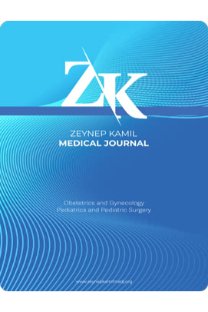Hiperprolaktinemide total antioksidan düzey: bromokriptin tedavisinin etkileri
Hiperprolaktinemi, Bromokriptin, Folikül uyarıcı hormon, Prolaktin, Antioksidanlar
Total antioxidant status in hyperprolactinemia: effects of bromocriptine therapy
___
- 1. Crosignani PG . Current treatment issues in female hyperprolactinaemia. EurJObstet Gynecol Reprod Biol 2006; 125:152-64
- 2. Sikka SC. Relative impact of oxidative stress on male reproductive function. Curr Med Chem 2001,-8:851-62
- 3. Peake JM, Suzuki K, Coombes JS . The influence of antioxidant supplementation on markers of inflammation and the relationship to oxidative stress after exercise J Nutr Biochem
- 2007;18:357-71 4. Salvemini D, Doyle TM, Cuzzocrea S
- Superoxide, peroxynitrite and oxidative/nitrative stress in inflammation. Biochem Soc Trans 2006:34:965-70
- 5. Şerri O, LiL, MamputuJC, et al. The influences of hyperprolactinemia and obesity on cardiovascular risk markers: effects ofcabergoline therapy. Clin Endocrinol (Oxf) 2006:64:366-70
- 6. Bankowski BJ, Zacur HA. Dopamine agonist therapy for hyperprolactinemia. Clin Obstet Gynecol 2003,46:349-62
- 7. Touraine P, Plu-Bureau G, Beji C, et al. Long term follow-up of246 hyperprolactinemic patients
- Acta Obstet Gynecol Scand 2001:80:162-8
- 8. Di Sarno A, Landi ML, Cappabianca P, et al
- Resistance to cabergoline as compared with bromocriptine in hyperprolactinemia: prevalence, clinical definition, and therapeutic strategy. J Clin Endocrinol Metab 2001:86:5256-61
- 9. Kitamura Y, Taniguchi T, Shimohoma S, et al
- Neuroprotective mechanisms of antiparkinsoniandopamine D2-receptor subfamily agonists.Neurochem Res 2003 ;28:1035-40
- 10. Erel O. A novel automated direct measurement method for total antioxidant capacity using a new generation, more stable ABTS radical cation
- Clin Biochem 2004;37 277-85
- 11. Brand JM, Frohn C, Cziupka K, et al
- Prolactin triggers pro-inflammatory immune responses in peripheral immune cells. Eur Cytokine Netw 2004;15:99-104
- 12. Yavuz D, Deyneli O, Akpinar I, et al
- Endothelial function? insulin sensitivity and inflammatory markers in hyperprolactinemic pre menopausal women. Eur J Endocrinol 2003;149:187-93
- 13. Davis LM, Pel Z, Trush MA, et al
- Bromocriptine reduces steatosis in obese rodent models. J Hepatol 2006;45:439-44
- 14. Yoshikawa T, Minamiyama Y, Naito Y, etal
- Antioxidant properties of bromocriptine, a dopamine agonist. J Neurochem 1994; 62:1034-8
- 15. Nishibayashi S, AsanumaM, Kohno M, et al
- Scavenging effects of dopamine agonists on nitric oxide radicals. J Neurochem 1996; 67:2208-11
- 16. Muralikrishnan D, Mohanakumar KP
- Neuroprotection by bromocriptine against 1- methyl-4-phenyl-l,2,3,6-tetrahydropyridine- induced neurotoxicity in mice. FASEB J 1998 ;12:905-12
- 17. Hirakawa T, Minegishi T, Tano M, et al. Effect of prolactin on the expression of luteinizing hormone receptors during cell differentiation in cultured rat granulosa cells. Endocrinology 1999;140:3444-51
- 18. Kostal M, TosnerJ. The influence of latent hyperprolactinaemia on the levels ofLH, FSH, E2 and T in the midfollicular phase of the cycle
- Arc h Gynecol Obste t 1997;259:65-8
- 19. Smith MS, Bartke A. Effects of hyperprolactinemia on the control of luteinizing hormone and follicle-stimulating hormone secretion in the male rat. Biol Reprod 1987;36:138-47
- 20. Kauppila A, Kirkinen P, Orava M, et al. Effects ofmetoclopramide induced hyperprolactinaemiaduring early follicular development on human ovarian function. J Clin Endocrinol Metab 1984; 59:875-81 21. Cutie RE, Andino NA. Prolactin inhibits the steroidogenesis in mid-folucular phase human granulosa cells cultured in a chemically defined medium. Fertil Steril 1988;49:632 22. Strauch G, Valcke JC, Mahoudeau JA, et al
- Hormonal changes induced by bromocriptine (CB- 154) at the early stage of treatment. J Clin Endocrinol Metab 1977;44:588-90
- 23. Semple CG, Beastall GH, Teasdale G, et al
- Hypothyroidism presenting with hyperprolactinaemia. BrMedJ 1983; 286:1200-1
- 24. Oliv e KE, Hennessey JV. Marked hyperprolactinemia in subclinical hypothyroidism
- Arch lnt Med 1988;148:2278-9
- 25. Tenorio-Velazquez VM, BarreraD, Franco M, et al.Hypothyroidism attenuates protein tyrosine nitration, oxidative stress and renal damage induced by ischemia and reperfusion: effect unrelated to antioxidant enzymes activities. BMC Nephrol 2005 ;6:12
- 26. Venditti P, Balestrieri M, Di Meo S, et al. Effect of thyroid state on lipid peroxidation, antioxidant defences, and susceptibility to J eg Endorcinol oxidative stress in rat tissues. 1997; 155:151-7
- ISSN: 1300-7971
- Yayın Aralığı: 4
- Başlangıç: 1969
- Yayıncı: Ali Cangül
Memenin ''spindle ''hücreli malign tümörü/ sarkomatoid karsinom: olgu sunumu
Müberra Seğmen YILMAZ, Gözde KIR, Filiz ALPTEKİN, Kenan MURAT, Metin YÜCEL
Hiperprolaktinemide total antioksidan düzey: bromokriptin tedavisinin etkileri
Nural BEKİROĞLU, Ayşe GÜRBÜZ, Rana KONYALIOĞLU, SELÇUK AYAS, Akif ALKAN, Sadiye EREN
Anti Müllerian Hormon düzeylerinin invitro fertilizasyonda kullanımı
Namık Kemal DURU, SEYİT TEMEL CEYHAN, İbrahim ALANBAY, Murat MUHCU, Uğur KESKİN, İskender BAŞER
Periüretral submukozal enjeksiyon tedavisinin sonuçları
Arman ÖZDEMİR, Çetin ÇAM, Ateş KARATEKE, Turhan ARAN, Esra ARAN
Gebeliğe eşlik eden overin küçük hücreli karsinomunun büyük hücreli varyantı: olgu sunumu
SELÇUK AYAS, Ayşe GÜRBÜZ, Akif ALKAN, Ateş KARATEKE, Handan ÇETİNNER
Ovarian endometrioma boyutu ve anti müllerin hormon düzeylerinin korelasyonu
Namık Kemal DURU, SEYİT TEMEL CEYHAN, İbrahim ALANBAY, Uğur KESKİN, Murat MUHCU, İskender BAŞER
Yenidoğan döneminde sık rastlanmayan herediter deri hastalıklar: 3 olgu sunumu
Aysun KARADAĞ, Gülcihan KERİMOĞLU, Hüseyin DAĞ, Sayat GÜLBAYZAR, Sami HATİPOĞLU
Müberra Seğmen YILMAZ, Dilek YAVUZER, Nimet KARADAY, Aylin Ege GÜL, Gözde KIR
